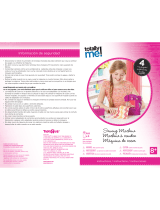
V
TABLE OF CONTENTS
SECTION I. NAMES OF PARTS
Names of Parts ................................................................ 2
Standard Accessories ...................................................... 4
Extension Table and Free Arm Sewing ............................ 6
• To detatch .................................................................... 6
• To attach ...................................................................... 6
• Free arm sewing .......................................................... 6
SECTION 2. GETTING READY TO SEW
Connecting the Power Supply.......................................... 8
Before Using Your Machine.............................................. 8
For Your Safety ................................................................ 8
Controlling Sewing Speed................................................ 8
Speed control lever ....................................................... 8
Foot control ................................................................... 8
Polarized plug .................................................................. 8
Function Keys and Buttons ............................................ 10
Reverse stitch button................................................... 10
Auto-lock button............................................................10
Up/Down needle position button.................................. 10
Mode selection key...................................................... 12
Pattern selection mode ............................................. 12
Stitch width adjusting mode ...................................... 12
Stitch length adjusting mode..................................... 12
Dropping the Feed Dog.................................................. 14
Raising and Lowering the Presser Foot ......................... 14
Changing the Presser Foot ............................................ 16
Detaching and Attaching the Foot Holder ...................... 16
Changing Needles.......................................................... 16
Thread and Needle Chart............................................... 18
Winding the Bobbin ........................................................ 20
Removing the bobbin .................................................. 20
Setting the spool of thread .......................................... 20
Additional spool pin ..................................................... 20
Winding the bobbin ..................................................... 20
Inserting the bobbin..................................................... 22
Threading the Machine .................................................. 24
Threading the machine .............................................. 24
Automatic Needle Threader ............................................26
Drawing Up Bobbin Thread............................................ 26
Balancing Thread Tension.............................................. 28
Tension is too tight ...................................................... 28
Tension is too loose..................................................... 28
Adjusting the needle thread tension for zigzag stitch .. 28
SECTION 3. BASIC SEWING
Straight Stitch Sewing .................................................... 30
Starting to sew ............................................................30
Changing sewing direction ......................................... 30
Fastening the seam.................................................... 30
Adjusting the Stitch Length ............................................ 32
Changing the Needle Drop Position............................... 32
Using the Seam Guides ................................................. 34
Turning Square Corners................................................. 34
Sewing from the Edge of Thick Fabric ........................... 34
Variety of Straight Stitches ............................................. 36
Basic Zigzag Stitch......................................................... 38
Adjusting the Stitch Width .............................................. 38
Adjusting the Stitch Length ............................................ 38
SECTION 4. UTILITY STITCHES
Overcasting (Zigzag stitch) ............................................. 40
Multiple Zigzag Stitch (Tricot stitch) ................................ 40
Overedge Stitch .............................................................. 40
Knit Stitch ........................................................................ 42
Serging Stitch.................................................................. 42
Automatic Buttonholes .................................................... 44
Square buttonhole........................................................ 44
Adjusting the buttonhle width and density .................... 50
Double layer buttonhole ............................................... 50
Round end/Keyhole buttonhole.................................... 52
Adjusting the buttonhole width ..................................... 52
Corded Buttonhole ....................................................... 54
Sewing on Buttons .......................................................... 56
Darning............................................................................ 58
Zipper Sewing ................................................................. 60
Fabric preparation...................................................... 60
Starting to sew ........................................................... 60
Blind Hem Stitch.............................................................. 64
SECTION 5. DECORATIVE STITCHES
Shell Tucking................................................................... 66
Decorative Satin Stitches ................................................ 66
Appliqué .......................................................................... 68
Scallop Stitch .................................................................. 68
Patchwork ....................................................................... 68
Smocking ........................................................................ 70
Fagoting .......................................................................... 70
Cross Stitch..................................................................... 70
Patchwork piecing ........................................................... 72
Quilting ............................................................................ 72
Stitch in the ditch with even feed foot.............................. 74
Pin Tucking...................................................................... 76
Pattern Combination ....................................................... 76
SECTION 6. CARE OF YOUR MACHINE
Adjusting Stretch Stitch Balance ..................................... 78
Replacing the Light Bulb ................................................. 78
Cleaning Hook Race and Feed Dog ............................... 80
Problems and Warning Signals ...................................... 82
Troubleshooting .............................................................. 85




















